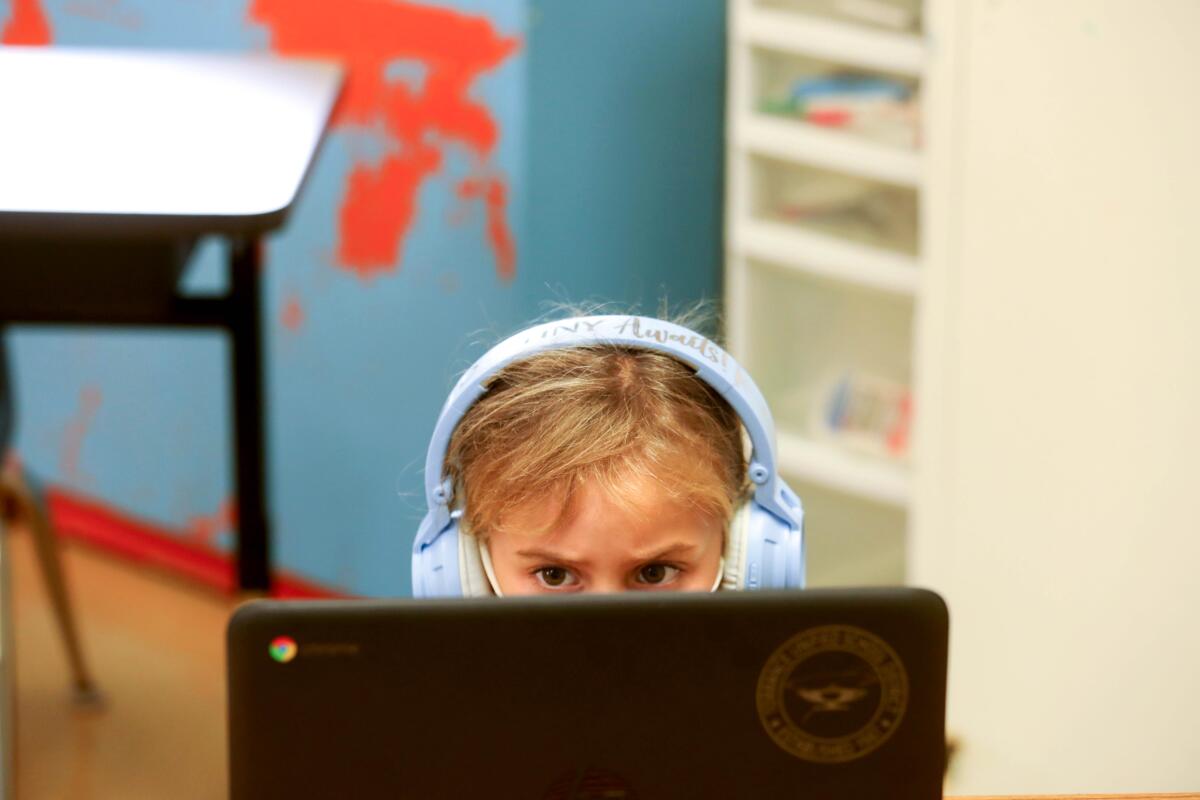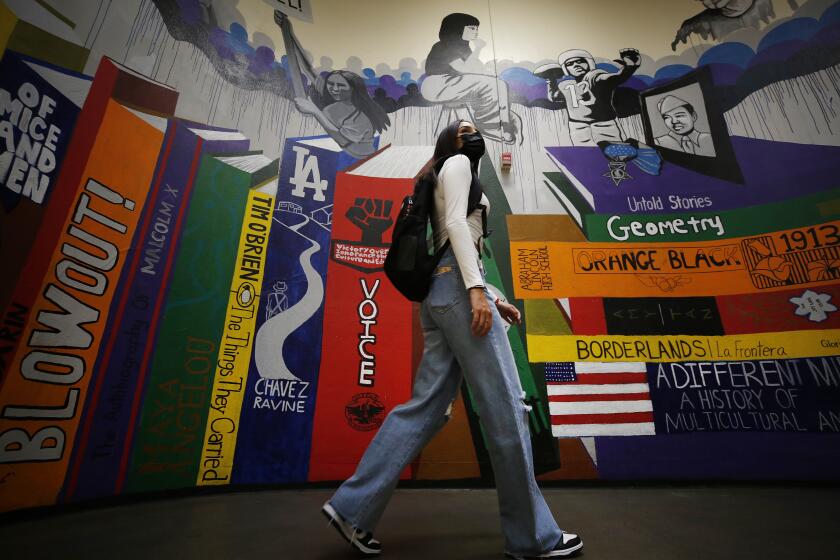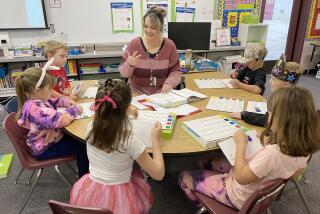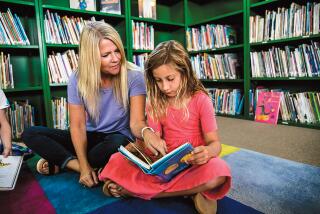First comprehensive data in two years show big academic setbacks for California students

California’s K-12 students experienced significant academic setbacks during the 2020-21 school year of mainly remote learning, showing growing achievement gaps, lagging progress in math and English, increased chronic absenteeism and a slight decline in the statewide graduation rate, according to data released Friday by the California Department of Education.
The data provide the most comprehensive picture yet of how California students have fared during the pandemic. It includes standardized test results for students from third to eighth grade and high school juniors, as well as information on attendance, discipline statistics and graduation rates.
The results show that about half of all California students tested did not meet state standards in English language arts and about two-thirds did not meet standards in math. The scores of Black, Latino and economically disadvantaged students were significantly lower, with more than 60% not meeting English standards and about 80% not meeting math standards.
In English language arts, the rate of students not meeting expectations was significantly higher in earlier grades compared with later grades, indicating that younger students may be uniquely struggling with literacy skills. For example, about 60% of third- and fourth-graders were not meeting standards in English compared to about 40% of 11th-graders.
The test results are the first statewide student achievement scores available after testing was canceled during the 2019-20 school year, when the pandemic forced campus closures in March 2020.
Some educators, parents and teachers unions, including United Teachers Los Angeles, were strongly opposed to administering standardized tests last spring, saying students and families did not need the added stress and results would be unreliable. Others, however, emphasized the importance of capturing assessment data to gauge student learning, and the State Board of Education voted last February against pursuing a waiver from the federal government to suspend mandated standardized testing for a second straight year.
School districts were given significant leeway to account for the fact that most students were still not attending school in person — shortened versions of the statewide tests were administered and districts were allowed to give their own local assessments, rather than use the statewide tests.
As a result, fewer than a quarter of students participated in the English and math statewide tests, a rate far lower than typical years, when a vast majority of students take the tests. The testing circumstances make year-to-year comparisons difficult.
A Los Angeles Times analysis of data offers an alarming assessment of the impact of the pandemic on L.A. students.
In an effort to offer some comparison to previous years, state officials analyzed the test scores of the same cohort of students year after year. Those results show that while students made progress, it was at a slower rate than previous years. In 2019, for example, the mean score increase in math for students between fourth and sixth grade was 52 points. In 2021, scores still increased, but only by 18 points.
Linda Darling-Hammond, president of the state board of education, said that while the results signal lags in learning, there is also reason for optimism.
“The story is challenging but not as challenging as I expected it might be based on other projections — and for the older kids it’s much less discouraging than what we would have feared,” she said.
She noted that the schools now have more funding that allows them to expand the types of support they offer children, including summer school, tutoring, social emotional support and outreach to families.
“So many districts have prioritized social and emotional supports and learning and I think that’s absolutely critical,” she said. “You cannot learn when you are traumatized. Schools have to be a lot more than a place you show up and sit in a seat and read chapters and take tests.”
Rick Miller, chief executive officer of the CORE Districts, a consortium of large California school districts, said it is important to acknowledge that students did make gains last year.
“I think we can all agree distance learning was not as effective as in classroom,” Miller said. “But some progress was made and it’s important to honor that. Teachers are exhausted, administrators are exhausted. They worked so hard to make progress last year and some was made.”
But, he added, it’s clear that some of the state’s long-existing academic struggles were exacerbated — especially in math.
In addition to the state data, Miller said, data from the CORE Districts — which include Los Angeles, Sacramento, Santa Ana and Long Beach Unified, among others — show that Ds and Fs have increased in high school math classes, especially for freshmen taking Algebra.
“We definitely have, across the state, a math problem,” he said. “We’re just not getting as a state where we need to be ... we’ve always known this. We’ve seen it before. But now it’s at a crisis level where we need to pay attention.”
According to the state assessment data, about 70% of all students tested in fifth, sixth and eighth grades did not meet math standards. In fourth, seventh and 11th grades, about 65% of students did not meet standards.
State officials acknowledged that the numbers underscore the difficulties experienced by children during remote learning.
“The challenges that students and educators faced during the pandemic were multidimensional and disruptive to learning and mental health,” state Supt. of Public Instruction Tony Thurmond said in a news release. “Our goal now is to move all students forward.”
The four-year graduation rate fell from 84.2% in 2019-20 to 83.6% last year. Though the dip was small, it was the second year of small declines after years of steady growth. The biggest drop was among Black students, whose graduation rate fell more than four percentage points from 76.8% in 2019-20 to 72.5% last year.
Heather Hough, executive director of the research center Policy Analysis for California Education, said the impact of even a small dip in the graduation rate is significant and needs attention.
“For that 4%, those are students whose life trajectories have perhaps been changed forever,” she said. “The question for community colleges or for our post-secondary system is: How can we reengage those students to help them get the skills and training that they deserve to help them achieve their goals?”
Rates of chronic absenteeism, in which students are absent for at least 10% of school days, also grew from about 12% to 14%. The increases were even bigger for the most vulnerable students, including Black, Latino, Native American, foster and homeless youths, migrant students and English learners.
The data add to a significant body of evidence of the harm of the pandemic and school closures on student achievement. Nationwide, studies have repeatedly shown the most vulnerable students suffering the most significant setbacks.
This fall, an L.A. Times analysis of Los Angeles Unified data found deep drops in assessment scores or below grade-level standing in key areas of learning, with Black, Latino and other vulnerable students especially hard hit.
Hough, who has closely examined data on learning lags in California during the pandemic, said she worries that the numbers released Friday underestimate student setbacks.
“Those students who didn’t participate are probably the most likely to have been disconnected from online learning, to be chronically absent or to not have as much support at home,” she said. “The results are alarming. I think they underscore something we have understood from prior research.”
Though many schools have committed this year to help students get back on track — with added staff, expanded services and an increased focus on social and emotional well-being — staffing shortages, continued COVID-19 surges and other challenges created by the pandemic continue to upend their plans, Hough said.
“It’s been really difficult for districts and schools to do the work of focusing on acceleration because we’ve found ourselves continuing to be in crisis mode this year,” she said.
More to Read
Start your day right
Sign up for Essential California for news, features and recommendations from the L.A. Times and beyond in your inbox six days a week.
You may occasionally receive promotional content from the Los Angeles Times.








